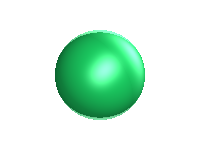Hard sphere model: Difference between revisions
Jump to navigation
Jump to search
Carl McBride (talk | contribs) |
Carl McBride (talk | contribs) |
||
| Line 35: | Line 35: | ||
== Experimental results == | == Experimental results == | ||
For results obtained from the CDOT experiments performed on-board the Space Shuttles ''Columbia'' | For results obtained from the CDOT experiments performed on-board the Space Shuttles ''Columbia'' and ''Discovery'' see Ref. 3. | ||
==References== | ==References== | ||
Revision as of 16:34, 13 March 2007

Interaction Potential
The hard sphere interaction potential is given by
where is the potential energy between two spheres at a distance , and is the sphere diameter.
Equations of state
Hard sphere fluid:
- See Carnahan-Starling (three dimensions)
- See Ref.1
Hard sphere solid:
- See Ref. 2
Related systems
Hard disks in a 2-dimensional space
Hard rods in one dimension
Data
Virial coefficients of hard spheres and hard disks
Experimental results
For results obtained from the CDOT experiments performed on-board the Space Shuttles Columbia and Discovery see Ref. 3.
References
- Robin J. Speedy "Pressure of the metastable hard-sphere fluid", Journal of Physics: Condensed Matter 9 pp. 8591-8599 (1997)
- Robin J. Speedy "Pressure and entropy of hard-sphere crystals", Journal of Physics: Condensed Matter 10 pp. 4387-4391 (1998)
- Z. Chenga, P. M. Chaikina, W. B. Russelb, W. V. Meyerc, J. Zhub, R. B. Rogersc and R. H. Ottewilld, "Phase diagram of hard spheres", Materials & Design 22 pp. 529-534 (2001)



